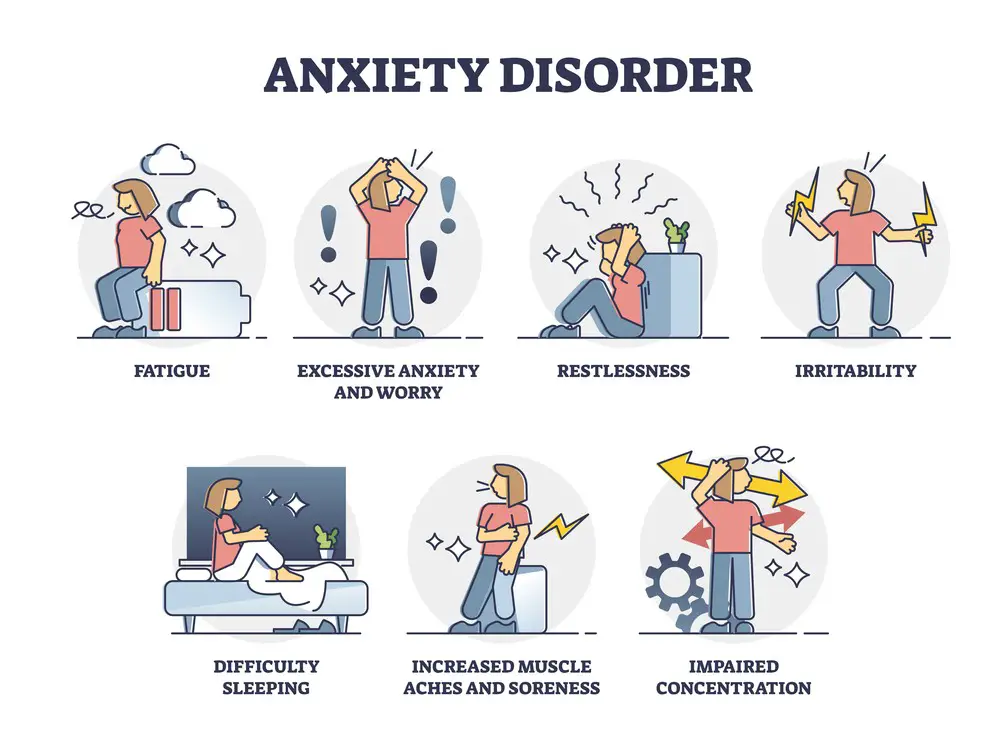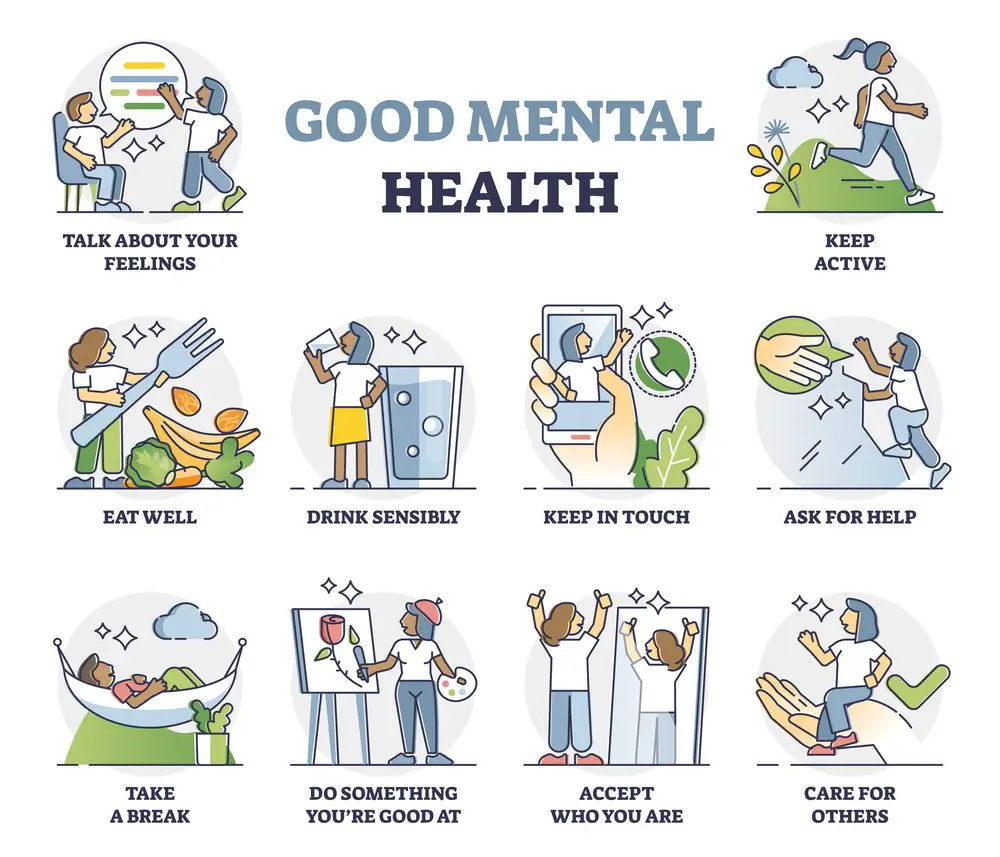As a BetterHelp affiliate, we receive compensation from BetterHelp if you purchase products or services through the links provided
Feeling anxious? You’re not alone. Anxiety can sneak up on us in the most unexpected moments, making the simplest tasks feel like mountains to climb. But what if you could arm yourself with a tool that fits right in your pocket—positive affirmations for anxiety? Intrigued? In this post, we’re diving deep into:
- The psychological underpinnings of why positive affirmations can alleviate anxiety
- Tailoring affirmations to your unique situation for maximum effectiveness
- How to seamlessly incorporate them into your daily routine for a lasting impact
So, whether you’re skeptical or already a believer in the power of positive thinking, stick around. This is your guide to harnessing the transformative power of words for a calmer, more centered you.
Understanding Anxiety and Affirmations

Anxiety and Its Impact
Anxiety is a common and often debilitating emotional state characterized by excessive worry, fear, negative thoughts, and unease. It can profoundly impact one’s mental and physical well-being, affecting daily life, relationships, and overall quality of life.
What Is Anxiety?
Anxiety is a natural stress response, but when it becomes chronic or overwhelming, it can lead to various symptoms, including restlessness, rapid heartbeat, muscle tension, and intrusive thoughts. Generalized Anxiety Disorder (GAD), social anxiety, and panic disorder are common anxiety disorders.
Effects of Anxiety
The effects of anxiety extend beyond mental distress, impacting physical health, sleep, and overall life satisfaction. Chronic anxiety can contribute to various health issues, such as cardiovascular problems, digestive disorders, and weakened immune function.
The Power of Mindset
The power of mindset lies in its ability to shape our perception of the world and influence our emotional responses. Our positive or negative mindset can significantly impact our mental well-being. A positive mindset means optimism, anxiety relief, positive energy, self-belief, and resilience, while a negative one can lead to self-doubt and anxiety.
Positive affirmations harness the power of mindset by providing a structured way to introduce and reinforce positive thinking and overcome negative self-talk. By regularly practicing affirmations, individuals can shift their mindset from one dominated by self-criticism and fear to one rooted in self-confidence and hope.

Positive Affirmations Explained
Positive affirmations are statements or phrases aimed at shifting one’s mindset and promoting a positive self-image. They are designed to overcome anxiety, replace negative thoughts and beliefs, and replace them with empowering constructive positive feelings.
What Are Positive Affirmations?
Positive affirmations are concise, affirmative statements that reflect desired qualities, behaviors, or outcomes. They are often repeated regularly, silently or aloud, to reinforce a positive mindset and encourage beneficial actions.
How Do Affirmations Work?
Affirmations work by reshaping thought patterns and beliefs. They can alter neural pathways, enhance self-esteem, relieve stress, reduce self-doubt, and cultivate a more optimistic perspective when consistently practiced. By focusing on affirmations, individuals can harness the power of their thoughts to counter anxiety’s negative impact.
Scientific Basis
There is evidence to suggest that positive self-affirmations can have a positive impact on mental health. They may influence the brain’s neural plasticity, improving emotional regulation and resilience. Additionally, affirmations align with the principles of cognitive-behavioral therapy (CBT), a well-established treatment for anxiety and related disorders. However, their effectiveness can vary among individuals, and they are often most potent when integrated into a comprehensive approach to mental well-being.
Crafting Effective Affirmations
Creating Your Affirmations
Affirmations are most effective when personalized to address specific concerns and challenges. Tailoring them to individual needs and aspirations increases their relevance and impact.

Personalization
Crafting personalized affirmations involves identifying specific anxiety triggers or areas where one seeks improvement. By addressing individual goals and needs, affirmations become more meaningful and resonate deeply.
Positivity and Present Tense
Positive affirmations use positive words and are said as if they’re already happening. This boosts a positive mindset and makes you believe in your goals.
Affirmations for Specific Anxiety Types
Different anxiety types may require tailored affirmations. Crafting affirmations that directly address the challenges associated with social anxiety, generalized anxiety, or specific phobias can be especially beneficial.
Incorporating Affirmations into Daily Life
Morning and Evening Routines
To maximize the impact of affirmations, incorporating them into daily routines can be highly effective. Many people start their day with positive affirmations to set a proactive and optimistic tone. Additionally, affirmations can be revisited in the evening to reinforce positivity and promote relaxation before bedtime.
Visualization Techniques
Complementing affirmations with visualization techniques can enhance their effectiveness. By vividly imagining the desired outcomes while reciting affirmations, individuals can strengthen their belief in their ability to achieve those goals.
Journaling and Tracking Progress
Maintaining a journal to record affirmations and track progress can provide valuable insights. It allows individuals to reflect on their journey, recognize changes in thought patterns, and assess the impact of affirmations on their anxiety levels. Journaling can be a powerful tool for self-discovery and personal growth.
Overcoming Common Challenges

Dealing with Resistance and Skepticism
While positive affirmations can be transformative, they may face resistance and skepticism. Overcoming these challenges is essential for their effectiveness.
Addressing Doubts
Addressing doubts involves recognizing and challenging negative self-talk or skepticism about the effectiveness of affirmations. Self-compassion and reminding oneself of past successes can help counter doubts.
Patience and Consistency
Achieving lasting change through affirmations requires patience and consistency. Individuals may not see immediate results, so continuing the practice is essential even when progress seems slow.
Seeking Support
Seeking support from friends, family, or mental health professionals can provide encouragement and guidance when facing resistance or skepticism.
What if I feel like I’m lying to myself?
It’s common to have doubts initially. Remind yourself that affirmations are about promoting positive thinking and mindset change. Over time, these positive beliefs can become more ingrained.
How long until I achieve noticeable results?
The timeline for noticeable results can vary. Some individuals may experience changes in a few weeks, while for others, it might take longer. Consistency and patience are key.
- Adapting Affirmations Over Time
- Growth and Change
As individuals grow and change, their affirmations may need adjustments to align with evolving goals and needs. Adapting affirmations ensures they remain relevant and practical.
Fine-Tuning Your Affirmations
Fine-tuning affirmations involves refining the wording or focus to better resonate with personal aspirations and challenges. Customizing affirmations can enhance their impact.
Seeking Professional Guidance
In some cases, seeking guidance from a mental health professional or therapist can help individuals adapt their affirmations effectively, especially when dealing with complex mental health issues or deep-seated beliefs.
When should I consider seeking professional guidance?
Consider seeking professional guidance if your affirmations are not producing the desired results or if you’re dealing with specific mental health issues that may benefit from therapeutic support.
Can I adapt my affirmations frequently?
Adapting affirmations to reflect changing goals and needs is encouraged. However, frequent changes without allowing time for the affirmations to take effect may limit their effectiveness. Balance is key.

When It’s Time to Dial It Up a Notch: Signs Professional Help is Needed
Positive affirmations are fantastic, but they’re not a catch-all solution. Here are some indicators that it might be time to add a professional to your anxiety-fighting arsenal:
- Persistent Worries: If your thoughts are like an unstoppable train that you can’t seem to get off, it’s time to consult an expert.
- Physical Symptoms: When anxiety starts manifesting physically—say, as sleep issues, headaches, or even digestive problems—you should take it as a sign to seek help.
- Quality of Life: If you’re avoiding social situations, missing work, or just generally feeling unhappy, a professional can provide more structured support.
- When Affirmations Aren’t Enough: If you’ve been using positive affirmations but aren’t seeing significant changes, it might be beneficial to explore other therapeutic options.
Your Personal Blueprint: Setting Goals
Positive affirmations work best when you have clear goals in mind. Let’s discuss how to set goals that resonate with you:
- Identify Triggers: Know what sets off your anxiety. Is it work? Social interactions? Set goals to use affirmations during these trigger moments.
- Make It Routine: Aim to incorporate affirmations into your daily life, maybe as a morning mantra or a bedtime ritual.
- Fine-Tune Your Phrases: Personalize your affirmations. The more they resonate with you, the more effective they will be.
- Be Realistic: Set achievable, specific goals. Instead of saying, “I’ll never be anxious again,” aim for more manageable targets like “I’ll use affirmations to cope with anxiety during meetings.”
The Proof is in the Pudding: Monitoring Progress
Success is sweeter when you can measure it. Here’s how to keep tabs on your progress:
- Journaling: Write down how you feel before and after using affirmations. Over time, you might notice patterns or even improvements.
- Mental Check-ins: Pause periodically to assess your anxiety levels. Is your heart still racing at the thought of public speaking, or is it getting easier?
- Ask for Feedback: Don’t hesitate to ask close friends or family if they’ve noticed a change in your demeanor. Sometimes, external perspectives can offer valuable insights.
- Review and Adapt: Every couple of weeks, review your goals and the progress you’ve made. Tweak your affirmations or your approach based on what you find.
You can confidently navigate the often murky waters of anxiety by taking a holistic approach—using positive affirmations, setting personalized goals, and knowing when to seek additional help.
Frequently Asked Questions (FAQs)

Can positive affirmations help with anxiety?
Yes, positive affirmations can help with anxiety by reshaping thought patterns and promoting a more positive mindset.
How long does it take to see results from using affirmations for anxiety?
The time to see results from using affirmations for anxiety varies among individuals. Some may notice changes in a few weeks, while others may take longer. Consistency is key.
What if I find it challenging to believe in the affirmations I create?
If it’s challenging to believe in the affirmations you create, start with smaller, more believable statements and gradually work towards more empowering ones as your confidence grows.
Jacob Maslow
After surviving the traumatizing events of 9/11, I took it upon myself to heal through helping others. I’m the primary caregiver of my children and understand from first-hand experience the lonely paths you have to walk as a partner and parent when leaving an unhealthy relationship.
We’re all echoing in a dark space that doesn’t have to be this empty, and that’s been my mission since finding solace and recovery in therapy: To help comfort others who are still in shock and at the prime of their struggle.
I came across BetterHelp after searching for this type of community. I wanted to belong to a body of proactive therapists and supportive therapy veterans that allowed me to see other sides of the story.
It was unconventional, and that’s what attracted me most. During my most challenging times, when my ex-wife completely cut me off from my children, I found comfort and clarity through BetterHelp.
Instead of being chained to a strict therapist recommendation, I was in charge of who I felt understood my struggle most. That allowed me to find my true peace, as I was reunited with those who read behind my words and had first-hand experience with my trauma.
Recovery is a choice; with BetterHelp, that choice will be a few clicks away. You can join their couples-oriented platform, Regain.us, for those stuck with family estrangement and toxic relationship patterns.
- Left Arm Pain and Anxiety: Understanding the Relationship - November 23, 2023
- Anxiety Paralysis: Coping with Overwhelming Stress - November 23, 2023
- Anxious vs. Nervous: Differentiating Emotions and Responses - November 15, 2023
This site contains affiliate links to products. We will receive a commission for purchases made through these links.



